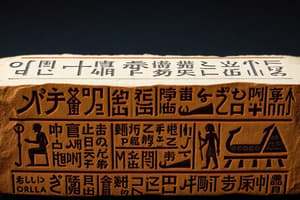Podcast
Questions and Answers
Flashcards are hidden until you start studying
Study Notes
- The British Museum houses the famous Rosetta Stone, a crucial artifact for deciphering Egyptian hieroglyphs and a valuable treasure of the museum. It is a replica that visitors can touch, as the original is kept in a heavily protected vault.
- The Rosetta Stone was discovered during Napoleon Bonaparte's campaign in Egypt. It contained the same text in three scripts: hieroglyphs, demotic, and Greek.
- The text on the Rosetta Stone had been hidden for centuries, before being unearthed and recognized for its importance. Prior to the discovery, no one in modern times knew how to read Egyptian hieroglyphs, and they were believed to be purely ideographic.
- The key to deciphering hieroglyphs was the identification of cartouches – circles with lines that marked the names of the pharaohs. With the help of these markings, scholars could identify known names and bridge the gap between the scripts.
- The Rosetta Stone is an ancient tax record for a priest, detailing his privileges and exemptions. It provides valuable insights into the ancient Egyptian culture and its administrative practices.
- The British Museum is creating four new series for YouTube. The most popular one will be produced. To learn more, visit their YouTube channel and express your preference. The museum granted special access to the speaker to explore the museum outside of regular hours.
Studying That Suits You
Use AI to generate personalized quizzes and flashcards to suit your learning preferences.




